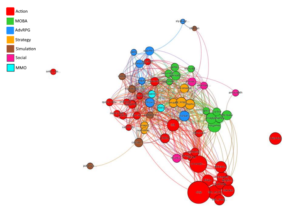Introduction
In lecture we discussed ideas of SCC and clusters or components which seem more “connected”. We learned about Mark Granovetter’s work on modelling a graph using strong and weak ties, and implications of this in our graphs. In this paper we will discuss the existence of global factions and overall “connectedness” of these factions in terms of different facets pertaining to the stream community on Twitch.tv. For some context, Twitch is an online streaming platform (owned by Amazon) where there are 2 main classes of users: streamers and viewers. Among these are subclasses such as moderators, organizations, etc. A streamer may stream their content of choice, from video games such as TFT, to “Just-Chatting” streams that may deal with real-world issues like mental health. For this paper we will focus on the gaming community and investigate connections between popular streamers and types of games that they play. This analysis is important as it can be used to identify trends in the gaming community and can allow an average streamer to maximize their impact/outreach/profit to follow the meta.
Research
A research paper analyzed popular and average Twitch streamers in relation with the types of games they played. Consider this graph (taken from the paper)

Nodes are popular streamers where the size of the node correlates with the average viewer count they receive over a certain point in time. Edges appear between nodes if the streamers have one or more viewers (followers) in common. We can see a visual cluster in the bottom right, where there seems to be very popular streamers all playing the same type of game, in this case it is “Action”. There are edges between these popular streamers in the same game type, which makes sense as viewers who are interested in a certain game are more inclined to watch different streamers who stream the same game. This cluster has strong ties within the community, and “weak” ties to other factions. We can see streamers who stream the same game form coalitions that share the same viewer pool.
We can also see a number of edges from the “Action” cluster to the “MOBA”, this tells us that between popular streamers in their respective game type, the viewers of one are likely to also follow the content of the other. If we analyze the nodes with a high clustering coefficient, we may be able to find some communities which overlap in viewership, thus it is an interesting point to consider whether streaming in a particular game type is more effective if the goal is to reach a larger audience. Analyzing the ego network of a popular and “embedded” streamer may lead to discovery about the reach this node has, in other words, the amount of viewers of this specific streamer and game type, and the probability that these viewers will also be in other communities.
Conclusion
Some clusters in the gaming community x viewership can be analyzed to show what viewers look for in a stream and what constitutes their decision to explore other streams of similar genres. This information can be useful to the aspiring streamer to find out what is the most effective type of game to stream, or interesting to the average viewer to find similar games/communities to be a part of based on their current interests. We discussed the existence of coalitions/factions and why viewers inside a faction are more likely to watch another streamer playing the same game as opposed to a different game.
Sources
Dux, James. (2018). Twitch Social Network Analysis by Stream Attributes Including Gender, Game Genre, and Team Membership. 10.13140/RG.2.2.26920.62720.
One reply on “Using Network Science to Analyze Connections Between Streamers on Twitch.tv”
Cool analysis! When I think about graph theory with twitch streams, I think about streamer organizations like OfflineTV. Each of those streamers in that group have viewers very likely to also be following/subbing to other streamers in that same group. I know the streamers in offlineTV like to get together and streamer the same type of game together too.